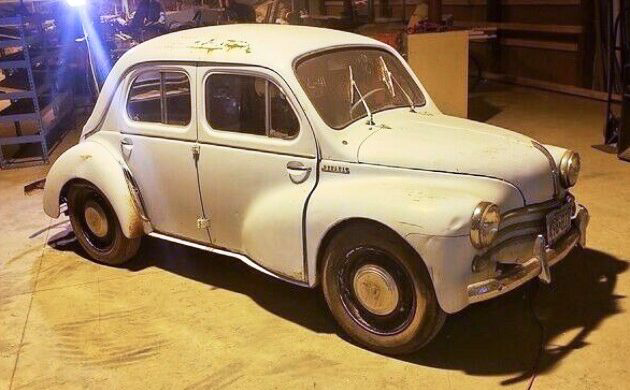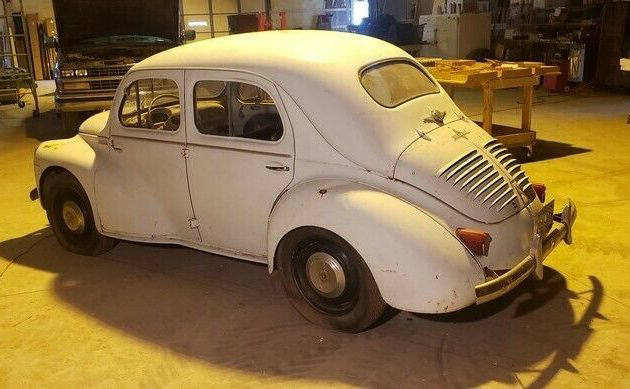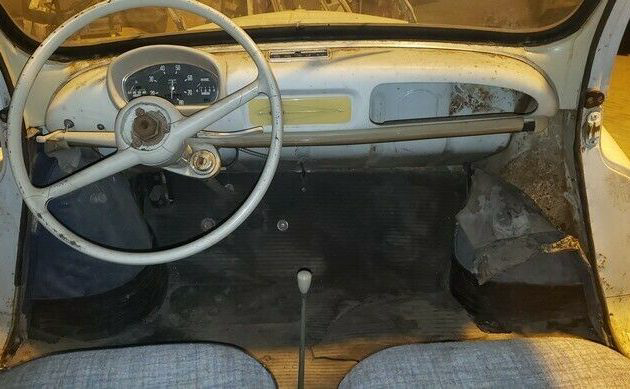Barn Find Survivor: 1959 Renault 4CV
Following World War II, it would be fair to say that the French economy was not in a healthy state. The government was keen to give it a kick-start, and part of that process was to get the population mobile again. However, with funds so tight, any cars that hit the market needed to be affordable, and the Renault 4CV filled that description perfectly. It was launched in late 1947 and remained in production until 1961. This 1959 model is a great example that has been parked in a barn for many years. It is virtually complete, and it is also surprisingly solid. It would be ideally suited to the person who is seeking to tackle a hands-on restoration project. Located in Osakis, Minnesota, you will find the 4CV listed for sale here on eBay. Bidding has reached $630, but the reserve hasn’t been met.
It seemed that there was a post-war competition between French vehicle manufacturers to see who could produce the quirkiest car. Citroen probably won with the 2CV, but Renault wasn’t far behind with the 4CV. Initially developed in secret during the war as a 2-door, the car morphed into a 4-door family sedan by the time it first broke cover in 1946. It is also a car that was built with one of my favorite classic design features. I have always been a sucker for suicide doors, making this one an attractive vehicle in my book. This little 4CV has remained hidden away in a barn for many years, and you would have to think that the storage environment has been pretty favorable. Rust is always the great enemy of the 4CV, but this Rejane White example springs a surprise on this front. There is some minor rust in the front floor, but it appears that this could be addressed with patches. The owner doesn’t believe that it is bad enough to warrant immediate attention, but given the reputation that I’ve just mentioned, I would probably tackle it ASAP. Some surface corrosion is visible in a few places, which should also be addressed before it gets any worse. If I were to buy this car, there would be no half-measures. Due to the construction techniques employed on the 4CV, I would probably dismantle the vehicle entirely and undertake a ground-up restoration. These are not a complex car to disassemble, and modern corrosion treatment techniques would allow the buyer to give this classic the chance of surviving intact for another 62-years. The panels wear a few minor dings and dents, but they all appear to be repairable. The chrome is all present, but some of it will require restoration. The glass seems to be in good order, but the seals might need to be replaced.
Initially introduced with a 760cc engine, the 4CV received a revised 747cc 4-cylinder engine in 1950. This unit pumped out 28hp, which found its way to the rear wheels via a 3-speed manual transaxle. That was not a lot of power to play with, which means that it is no surprise that the journey down the ¼ mile took a leisurely 24.9 seconds. If the driver kept the right foot welded to the floor, the 4CV eventually ran out of breath at 62mph. Getting to that speed did take some patience because it took 48.7 seconds to achieve it. Flexibility was this little engine’s key attribute, with the car capable of pulling away in 2nd gear from speeds as low as 3mph. With no synchromesh on low gear, this proved to be a blessing in heavy traffic conditions. This Renault is virtually complete. The starter is missing, but I’ve had no problems finding replacements for around $300. The owner has tried turning the engine with a crank, and he believes that it has good compression. I wouldn’t be rushing into coaxing it back to life after decades of inactivity. It deserves a thorough inspection, and even if a rebuild is required, parts are cheap, and they are easy to work on.
The 4CV was designed as affordable transport for the masses. As such, the interior is not weighed down with a lot of luxury items. Let’s be honest here because it doesn’t have any luxury items. There is a spot in the center of the dash where an owner could fit a radio, but that’s about it. Renault designed the 4CV to seat four people, although it could fit five at a pinch. This interior needs some work, but its simplicity means that the buyer could tackle many of the tasks in a home workshop. The upholstery on the seats looks quite good, but the headliner has rodent damage. If the buyer is careful, they could remove it and utilize it as a template to make a replacement. There are no door trims, but they could also be made at home since they are flat trim items. The painted surfaces need a refresh, and the wheel needs to be restored or replaced. Complete those tasks and swap in a new rubber floor mat or carpets, and the interior would present exceptionally well. Rubber mats can be found for around $150, but the luxury of fitted carpet sets will cost about twice that amount.
The Renault 4CV was designed to get the French people mobile, and it successfully achieved this. It became the first French car to sell more than one million units, and 1.1 million had found their way onto the road by the time production ceased. It was also built in seven other countries, generating much-needed foreign revenue for the French economy. Sadly, rust consumed many of those cars, so finding a solid project vehicle like this one is something of a treat. Today, good examples regularly sell for $11,000 or more. Depending on where the bidding ultimately goes on, this little French classic is a project car that could be worth considering if you are looking for something a bit quirky.
Auctions Ending Soon
 1965 Ford Falcon Station WagonBid Now2 days$2,300
1965 Ford Falcon Station WagonBid Now2 days$2,300
 2002 Jaguar XK8 ConvertibleBid Now3 days$4,250
2002 Jaguar XK8 ConvertibleBid Now3 days$4,250
 1979 Chevrolet Camaro Z/28Bid Now4 days$4,500
1979 Chevrolet Camaro Z/28Bid Now4 days$4,500
 1960 Dodge D300Bid Now4 days$300
1960 Dodge D300Bid Now4 days$300
 2006 Ford Mustang Saleen S281 SCBid Now6 days$100
2006 Ford Mustang Saleen S281 SCBid Now6 days$100






Comments
I’m quite drawn to this vehicle; I don’t know why, as I like big cars (and I cannot lie).
Maybe it’s the juxtaposition of it against my big, thirty luxurious Caprice.
Is this “less is less”, or “less is more”? Seems to me it would be just as fun on the back roads of America. No radio means more conversation, or just more silence.
The seller is in a town right by a lake. Bet it would be fun navigating the roads around the body of water…
As some may already know, my and my brothers 1st car, and a ’59 too. A starter for $300 bucks? We paid $25 bucks for the entire car in 1972. Hey, it was only 40 years ago, what possibly could have changed? I said on the last one, I believe the finned valve cover meant something,( Billancourt?) and to be clear, this car wouldn’t go 60 mph, so 0-50 times were used. It was one of Renaults biggest sellers, and the 1st French car to sell over a million units.They were reproduced in several countries, and was used as police and taxi cabs for years. It was better than the VW, in that, it had 4 doors, more room and a real heater,( which is missing here) of sorts. I’ve had at least a hundred of vehicles since then, but you never forget your 1st,,,,,car that is.
Less performance than a Honda Z600. A priest gave my fraternity brother a Dauphine, (way up market) and he lost on the deal.
These did not compete with a VW. 1) Way less reliable. 2) Rusted on the boat. 3) Undrivable on a highway.4) Doors only usable by munchkins.5) Horrible dealer network with poor parts supply. But they were dirt cheap.
Having just completed the overhaul of my ’61 Dauphine engine, I can say with authority the 845cc engine is simple and easy to work on. It has sleeves with copper seals where they mate to the block and one must carefully measure/machine the amount of protrusion above the deck of the block to maintain proper sealing of the cylinder head gasket.
In many ways the Renault was ahead of their time. Notice the air inlet where the front of the rear fender meets the body? That should be the area for the air intake for the cooling system as the radiator is positioned directly behind the rear seat (same as the later model mid-engine Ferraris). Be sure to “close” off the sides with fiberboard of similar material to ensure the air flows properly THROUGH the radiator instead of going AROUND the radiator.
You don’t have to machine the liners. They are adjusted (if necessary) with different thickness copper washers (rings) under the liners.
I don’t think the alloy rocker cover is original.
845cc liners fit into this engine as the stroke of 80mm is the same on all varients.
A small tractor was made with this engine way after car production stopped. The same engine was fitted to the R4 up to the 70s but turned it around for front wheel drive.
if you have to buy a starter find a 12 volt one from later R4 or other model. The Ducellier or SEV 12v generators from many French cars will fit. On some of them a small bracket needs to be ground off and welded back on on the opposite side.
I imagine the later 4-speed gearbox from the R4 could be adapted to fit as the extra speed is an extension on the front of the standard 3-speed.
Looks like the bidding got up to $1,075 (still did not meet reserve) but the seller removed the car from e-bay before the auction ended. Likely ended the auction early as the seller got a decent offer?
Call it wishful thinking or a gut feeling, but I suspect we will see an increase in demand for the simple cars of yesterday. They were easy to work on, unique, and sometimes appreciate in value.
Was Dr Porsche consulted on this while in prison immediately after WWII? I think a Dauphine Gordini or even an R8 engine might bolt in for more performance. Back in the day I thought JC Whitney had big bore kits for them.
I have seen pix of these racing in the original( and current) Mille Miglia so you must be able to get some more “poke” out of that motor. I love the looks..suicide doors and that lovely louvred engine cover. I have often wondering if a VW/Porsche motor would work back there..lid jacked up like an Abarth /Fiat..cool!
One of the cutest girls in my class at school had one of these on Gray, if memory serves, and we all went to the drugstore for sodas in it. There were four of us in the Renault in City Traffic. I remember the girl and the car. Thanks for the memories……………..
These cars have always reminded me of a play car I had as a kid. It fit perfectly in my hand as I would wind up the friction motor by revving the tires on the floor as fast as I could before I launched it for a fast ride.
I have this friction toy 4cv in Red. Missing one hubcap. Friction motor still works. Rare. I took it in trade with some plastic promo cars. Would love someone to buy it from me. Running out of room for “little cars. “
Is your 4CV friction toy from Japan and about 1/24 scale (or larger)? If so it may be a model of a Hino 750, a RHD 4CV built by Hino in Japan under license from Renault. I’m interested in it…can you send pictures and what you want for the toy?
mike7353ataoldotcom
No manufacturers markings anywhere that I can see. Will send pics. May be the end of the week. I won’t charge you a museum price but this certainly is an odd piece of Japanese tin and not often seen in my travels around the country. Stand by.
Find a Dauphine Gordini, or Caravelle engine (40hp) and gearbox(4 speed). Put them in this cute little oddball, paint it French racing blue, and wear a beret
The 2CV ugly duck has a large following here in California, but I’ve never seen one of these.
Brakes !
still calling rusty, abused cars like this ” Survivor ” ? If you listen…. you can hear the Car World laughing at this continued mis-use of the Classification on BF.
Coupla points from a long-time (since 1963)…owner
* a stock 4CV will top out at 70 mph–used to drive the FL Turnpike, foot to the floor and not worry about a speeding ticket with a 70 mph speed limit. I actually saw 85 mph plus after a somewhat hot-rodded engine rebuild that upped the hp to about 43.
* the finned aluminum valve cover was an aftermarket part (along with that cool tubular header manifold) made by Autobleu but fitted by the factory to all US-bound 4CVs from 1956 until 1961. The manifold alone was good for 2 hp (26 to 28) over the factory’s cast iron/aluminum manifold. And since it’s a 6 volt system, suggest the buyer get a 6 volt starter motor to replace the missing one.
* the car is also missing its entire heater assembly (core, blower, housing, hoses), its glovebox and the license plate light assembly
* it’s roomier inside than you might think. I once gave a ride to one of our college basketball players (6’7″). He couldn’t see out the windshield, but due to the domed roof, he didn’t hit his head.
* They’re OK on the highway. Mine’s been through 22 States in the US, and 9 more in Mexico (a trip to Mexico City and back). While in college I regularly drove it between NC and south Florida–in the days before Interstates.
* Economical too–over 100000 miles, I averaged 35.2 mpg–after an engine rebuild that netted me about 43 hp (and a switch to a 4 speed with a 4.37 final drive) I averaged over 40 mpg for 30,000 miles.
* Still have the 21 autocross trophies I won with it…in the small sedan class–on a tight course I could beat a 1275 Mini Cooper due to my 26 foot turning circle and a powerful return spring inside the steering box
* And it was soooooo much easier to work on than my wife’s 63 Beetle. I could actually reach things on the engine.